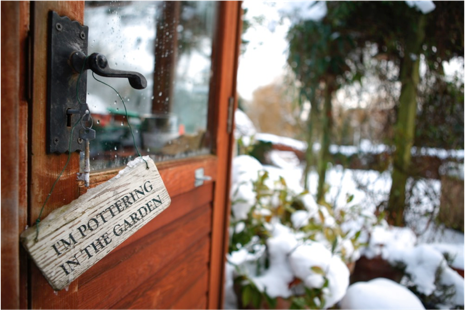Get Creative This Winter To Give Your Garden A Cosy Feel!
With the temperature dropping in recent weeks you may want to keep warm and stay inside. However there is no reason why you can’t make use of your garden all year round, and with these great tips you can still enjoy your outside space in the colder months.
1. Candles and Lanterns
Candles and Lanterns are perfect to give your garden a cosy feel, and are fantastic to use whatever the weather. Bring out some tall candles in calmer days and place them around your garden. You can use glass jars to keep them steady and protect them from the wind, or simply have them next to plant pots, on the edge of steps, or use floating candles if you have a pond. You can choose all white to keep it classy, or use a variety of coloured candles to brighten up your garden and give it a fun and magical feel. Colourful lanterns can also bring warmth to your garden and give it a lovely enchanted look.
2. Fairy Lights
Just because the festive season is over doesn’t mean you have to pack away the fairy lights just yet. Fairy lights are another great way to give your garden some sparkle during the winter months, and because it gets darker earlier they will have a great effect in the early evening. If you can’t plug your lights inside and lead them outside, why not invest in some solar lights? Despite the lack of sun, a good set will still charge during the day and then will light up your garden from dusk without you having to do a thing!
3. Winter Plants
Despite the cold, there are many plants that will thrive during this time of year. You can find a huge variety of plants that will do well in the cold, and for instant gratification choose from winter flowing plants such as the common pansy, or the more unusual Nepalese paper plant ‘Jacqueline Postill’ (Daphne bholua) which produces delightful pink flowers at this time of year. Berries and snowdrops are also great choices. It is also a good idea to pay attention to your soil at this time of year too. If there has been a lot of frost you may wish to thaw it out by placing some black plastic sheeting over the top. Turn your soil over regularly to keep it loose and add some soil conditioner to keep it in top condition.
4. Colourful Pots
Investing in some colourful pots at this time of year is a fantastic way to keep your garden cheerful all year round. There are plenty of garden centres and shops that sell a variety of coloured plant pots, or you can get creative and paint your own. Regardless of whether it is the right time to grow plants in them, this instant splash of colour will give your garden warmth and vibrancy whenever you look out of the window.
5. Outdoor Heaters
While spending long evenings sitting out in your garden may not be practical at this time of year, if you invest in a patio heater there is no reason why you can’t enjoy it. A fire pit or chiminea is another great option to keep you cosy, providing you use the right logs or coal. So invest in these if you fancy doing some winter star gazing in the evenings, or even invite people over for a winter BBQ -why not?!
So there you have it – with these tips you can keep your garden looking great, and more importantly, usable whatever the temperature. Wrap up warm, grab some blankets and get the fire going and you can enjoy your winter sanctuary until the sunshine reappears!


































